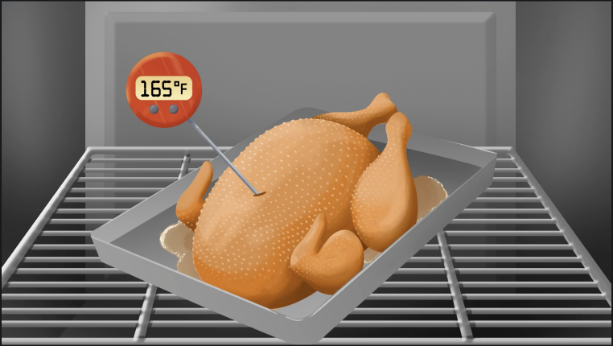Salmonella, Campylobacter and other harmful bacteria live on raw chicken.
Washing or rinsing doesn’t remove this: worse, it helps the bacteria spread. When you add water through washing or rinsing, you give this bacteria a way to travel throughout your kitchen.
Today’s poultry is already pretty clean. Our grandparents may have been cooking chicken that had some unsavory things on it, like waste or feathers. Today’s manufacturing cleans the chicken, so there is no filth, feathers, or anything else on it that needs to be washed off. Poultry may have a coating of water and protein: this gets cooked off, or you can remove it with a clean paper towel. Anything that is on the chicken will get cooked off.
Use a clean paper towel.
If you see anything on the chicken you want to get rid of, wipe it off with a clean paper towel.
Never rinse or wash chicken.
Raw chicken and juices should touch as few things as possible.
Separate raw chicken from fresh and ready-to-eat foods. Keep surfaces clean by washing them with hot, soapy water.

Cook it to 165 °F.
Cooking the chicken to 165 °F using a digital food thermometer will kill any dangerous bacteria, and make it safe to eat.
Young children and adults aged 65+ are more likely to get sick and be hospitalized from germs that cause foodborne illness.
Simple poultry handing steps will help you reduce the risk of illness from common germs that can cause food poisoning, such as Salmonella and Campylobacter.
Learn how to practice safe poultry handling
at the store and at home.
Are you aware that illnesses from Salmonella spike in the summer?
You can have a summer without Salmonella by following easy safe food handling steps!
Download Postcards (English and Spanish)
Download Flyer (English)
Download Flyer (Spanish)
Download PowerPoint
While warmer temperatures mean fun activities like barbecues and picnics, these activities call for particular attention to food safety steps.
These shareable resources social media graphics and downloadable flyer remind consumers what internal temperatures chicken and popular grilling meats need to reach to be safe.
Check out these safe recipes that feature chicken, turkey and other delicious ingredients! Our recipes build in food safety and hand hygiene steps provided by the Safe Recipe Style Guide.
Research shows that adding food safety instructions to recipes improves consumer food safety behaviors. Give these delicious dishes a try at home!

Resources for health and food safety educators

Print and digital resources for retailers

Consumer information in English and Spanish
Don’t Wash Your Chicken is based upon work that is supported by the National Institute of Food and Agriculture, U.S. Department of Agriculture, Agriculture and Food Research Initiative Competitive Grant No. 2019-68008-29908.
Any opinions, findings, conclusions, or recommendations expressed in this publication are those of the author(s) and do not necessarily reflect the view of the U.S. Department of Agriculture.
© 2022 New Mexico State University Board of Regents, Drexel University and New Mexico State University cooperating with the U.S. Department of Agriculture. Drexel University and NMSU are both equal opportunity/affirmative action employers and educators.

